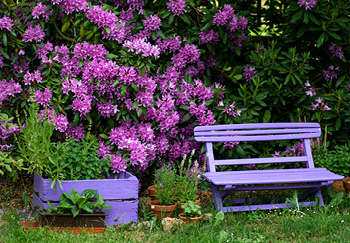Growing and Caring for Rhododendrons
November 6th, 2023 | Categories
Rhododendrons are one of the most popular flowering shrubs in the UK, and in many parts of the world. It’s easy to understand why with their dark green, long, leathery leaves, and wonderfully attractive often fragrant flowers that bloom in spectacular displays of reds, yellows, pinks, purples and white from spring to early summer. Many Rhododendrons are evergreen, but some are deciduous, there are also dwarf varieties. Rhododendrons come in varieties that grow to 50cm and some to 2m in height and larger still so they can become a real showcase. It’s worth noting that the Rhododendron family includes azaleas too though these tend to be smaller, bushier, with more flowers which are smaller in size by comparison.
They’re quite versatile and hardy plants too – no wonder since they were native to the Himalayas – being tolerant of many different light, temperature, and soil conditions, though they do need an acidic soil. They tend to do well in most places in the UK.
They also do very well in pots, which is great news for those with smaller garden spaces or hard landscaping. However, many gardeners prefer pots as they can more easily make the soil acidic and move them around depending on weather conditions.
Whatever growing conditions you have to grow a Rhododendron in, this guide will walk you through some key information to help your plant thrive and give you wonderful displays for years to come.
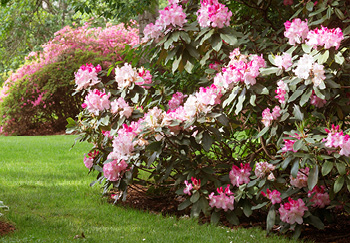
Rhododendron Factsheet
- Plant type: Shrub, mostly evergreen, some deciduous
- Flower colours: Pinks, purples, reds, oranges, yellows, white
- Flowers: Late March to July
- Prune in: March
- Sun exposure: Prefers partial or dappled shade ideally
- Hardiness: Hardy
- Soil type: Well drained, acidic soil
- Wildlife: Bees like it
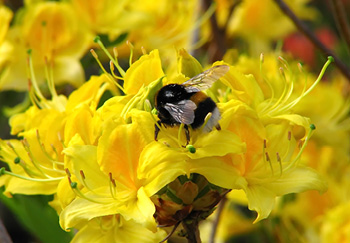
Types of Rhododendrons
Some Rhododendrons we love and are very popular are:
- Dreamland
- Kalinka
- Fantastica
- Sneezy
- Percy Wiseman
- Purple Gem
- Ginny Gee
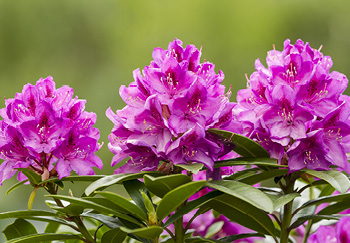
How to Grow Rhododendrons
If you’re new to Rhododendrons, then this guide will help steer you to success and wonderful blooms for years to come.
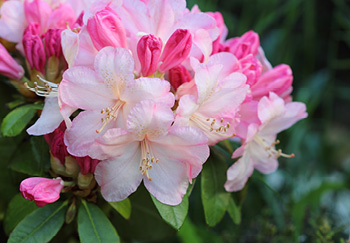
Specific Needs to Look Its Best
Rhododendrons prefer acidic soil with a pH between 4.5 and 6.0. No need fret about this though! You can easily purchase an ericaceous compost, which is specifically designed for acid-loving plants like Rhododendrons. Additionally, there are many other ways to introduce acidity to compost or soil over time with organic matter like well-rotted manure, wood chips, leaf mould, pine needles. Specifically made products are also available that can help such as a slow-release acidic pellet fertiliser, or acidic liquid concentrate fertiliser that gives a quick boost.
If your aim is to plant in a pot, fill it with ericaceous compost in the first year, then top up the acidity and nutrients in the coming years with these methods. If planting in the ground, each spring mulch around the base with a good amount of organic matter or gently dig in some of the pellets. It will also benefit from an appropriate liquid feed now and again through the growing season.
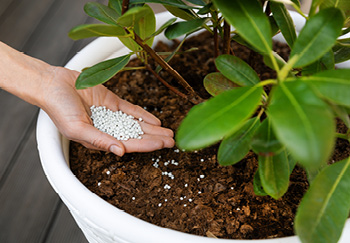
Where to Plant
A good, sheltered spot is best for Rhododendrons to protect them from cold winds. It likes partial shade, and is even tolerant of shadier conditions, but does require at least some sun throughout the day to really look its best. They don’t tend to do as well in full sun as they would in partial shade. More thought will be required if planting in the ground than in a pot, which can easily be moved at points to allow it both shelter and sun. Be sure to plant in a spot that is well draining as they don’t like to be waterlogged and can die from being overwatered.
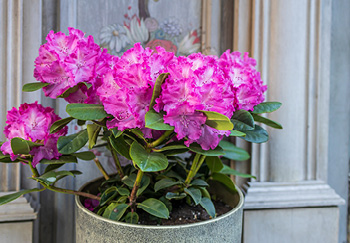
How to Plant
Whether planting in the ground or in a pot then it pays to know that Rhododendrons shouldn’t be planted too deeply due to their shallow roots. If they are they will struggle to flower. Aim to dig a hole that that the roots are just beneath the soil surface by a few inches at most.
A further tip when planting in the ground is to dig a hole about twice the size of what you need, and when planting in-fill with ericaceous compost and other organic material. This will give it plenty of nearby nutrients to seek out. Tease the roots out a bit to encourage them to seek out nutrients when planted.
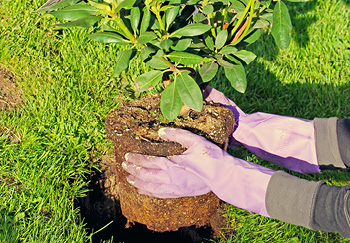
When to Plant
We think the best time to plant is in autumn, when the ground is still warm from the summer sun, but there’s more moisture from the autumn rains. Planting in autumn is good instead of spring and summer also because a combination of planting when a pant is gearing up to grow can increase the chances of a shock and other problems. Also, its roots would not be as developed to cope during periods of drought.
If you can’t wait until autumn or have missed the boat, then aim to plant as early as possible in the spring following the last frosts.
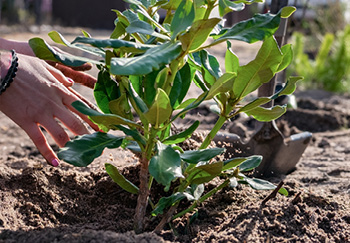
Ongoing Care
Rhododendrons are fairly low maintenance overall. They will benefit from a mulch of or ericaceous compost or any organic material mentioned earlier added around the base of the plant annually in spring. This will help to provide nutrients and keep the nearby soil acidic. A liquid feed of an appropriate fertiliser will also benefit it now and again through the growing season. They are quite hardy even to frosts but like any plant they will benefit from some protection like with a horticultural fleece.
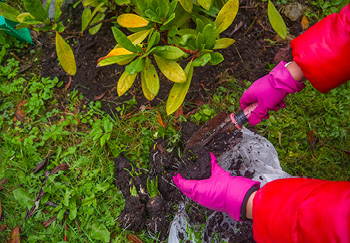
Pruning
As for pruning, there is usually very little need to prune, however, deadheading blooms after flowering will improve the appearance.
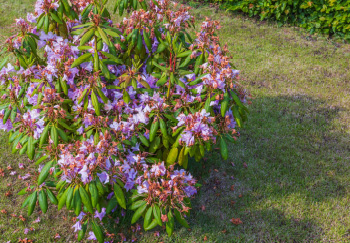
Companion Plant Ideas for Rhododendrons
Rhododendrons grow large enough to look fantastic on their own when they bloom, and you can plant several together in different colours to stunning effect. But, if you would like to include it amongst a variety of plants, then some companion plants we recommend with similar requirements are:
- Camellias
- Pieris
- Hydrangeas
- Bleeding Hearts
- Berberis
- Viburnum
- Azaleas
Rhododendrons are woodland plants, so they also look good when underplanted with plants like:
- Hostas
- Ferns
- Hellebores
- Longwort
Planting some of these alongside your Rhododendrons would create a lovely full looking woodland style border.
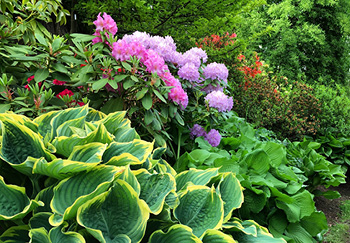
Have Beautiful Rhododendrons in Your Garden
Adding Rhododendrons to your garden can transform it into a place of wonderful interest with their size, colour, and fragrance. They are good no-nonsense easy to grow plants requiring very little attention – great for the modern gardener – though they will benefit from some care giving you fantastic blooms for years to come. Why not visit our garden centres or shop online to see our range today?
